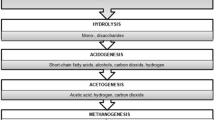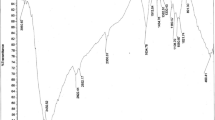Abstract
Sheer enormity of lignocellulosics makes them potential feedstock for biofuel production but, their conversion into fermentable sugars is a major hurdle. They have to be pretreated physically, chemically, or biologically to be used by fermenting organisms for production of ethanol. Each lignocellulosic substrate is a complex mix of cellulose, hemicellulose and lignin, bound in a matrix. While cellulose and hemicellulose yield fermentable sugars, lignin is the most recalcitrant polymer, consisting of phenyl-propanoid units. Many microorganisms in nature are able to attack and degrade lignin, thus making access to cellulose easy. Such organisms are abundantly found in forest leaf litter/composts and especially include the wood rotting fungi, actinomycetes and bacteria. These microorganisms possess enzyme systems to attack, depolymerize and degrade the polymers in lignocellulosic substrates. Current pretreatment research is targeted towards developing processes which are mild, economical and environment friendly facilitating subsequent saccharification of cellulose and its fermentation to ethanol. Besides being the critical step, pretreatment is also cost intensive. Biological treatments with white rot fungi and Streptomyces have been studied for delignification of pulp, increasing digestibility of lignocellulosics for animal feed and for bioremediation of paper mill effluents. Such lignocellulolytic organisms can prove extremely useful in production of bioethanol when used for removal of lignin from lignocellulosic substrate and also for cellulase production. Our studies on treatment of hardwood and softwood residues with Streptomyces griseus isolated from leaf litter showed that it enhanced the mild alkaline solubilisation of lignins and also produced high levels of the cellulase complex when growing on wood substrates. Lignin loss (Klason lignin) observed was 10.5 and 23.5% in case of soft wood and hard wood, respectively. Thus, biological pretreatment process for lignocellulosic substrate using lignolytic organisms such as actinomycetes and white rot fungi can be developed for facilitating efficient enzymatic digestibility of cellulose.

Similar content being viewed by others
References
Larson ED (2008) Biofuel production technologies: status, prospects and implications for trade and development. Paper presented at the United Nations conference on trade and development (UNCTAD) 2008
Sánchez OJ, Cardona CA (2008) Trends in biological production of fuel ethanol from different feedstocks. Bioresour Technol 99:5270–5295
Sukumaran RK, Surender VJ, Sindhu R, Binod P, Janu KU, Sajna KV, Rajasree KP, Pandey A (2010) Lignocellulosic ethanol in India: prospects, challenges and feedstock availability. Bioresour Technol 101:4826–4833
Holtzapple MT (1993) Cellulose, hemicelluloses, and lignin. In: Macrae R, Robinson RK, Sadler MJ (eds) Encyclopedia of food science, food technology, and nutrition. Academic Press, London
Bradley C, Wood P, Kearns R, Black B (1989) Biological delignification of wood and straw for ethanol production via solid state culture. Final Report, Montana Department of Natural Resources and Conservation, Montana, 1989
Alvira P, Tomas-Pejo E, Ballesteros M, Negro MJ (2010) Pretreatment technologies for an efficient bioethanol production process based on enzymatic hydrolysis: a review. Bioresour Technol 101:4851–4861
Mansfield SD, Mooney C, Saddler JN (1999) Substrate and enzyme characteristics that limit cellulose hydrolysis. Biotechnol Prog 15:804–816
Esteghlalian AR, Srivastava V, Gilkes N, Gregg DJ, Saddler JN (2001) An overview of factors influencing the enzymatic hydrolysis of lignocellulosic feedstocks. In: Himmel ME, Baker W, Saddler JN (eds) Glycosyl hydrolases for biomass conversion. ACS, Washington, DC, pp 100–111
Chang VS, Holtzapple M (2000) Fundamental factors affecting biomass reactivity. Appl Biochem Biotechnol 84–86:5–37
Taherzadeh JM, Karimi K (2008) Pretreatment of lignocellulosic wastes to improve ethanol and biogas production: a review. Int J Mol Sci 9:1621–1651
Chandra RP, Bura R, Mabee WE, Berlin A, Pan X, Saddler JN (2007) Substrate pretreatment: the key to effective enzymatic hydrolysis of lignocellulosics? Adv Biochem Eng Biotechnol 108:67–93
Tassinari T, Macy C, Spano L, Ryu DDY (1980) Energy requirements and process design considerations in compression-milling pretreatment of cellulosic wastes for enzymatic hydrolysis. Biotechnol Bioeng 22:1689–1705
Karunanithy C, Muthukumarappan K and Julson JL (2008) Influence of high shear bioreactor parameters on carbohydrate release from different biomasses. American Society of Agricultural and Biological Engineers Annual International Meeting 2008. ASABE 084114. ASABE, St. Joseph
Playne MJ (1984) Increased digestibility of bagasse by pretreatment with alkalis and steam explosion. Biotechnol Bioeng 26:426–433
Kumar R, Wyman CE (2009) Effects of cellulase and xylanase enzymes on the deconstruction of solids from pretreatment of poplar by leading technologies. Biotechnol Prog 25:302–314
Knappert H, Grethlein H, Converse A (1981) Partial acid hydrolysis of poplar wood as a pretreatment for enzymatic hydrolysis. Biotechnol Bioengineering Symp 11:67–77
Wyman CE (1996) Handbook on bioethanol: production and utilization. Taylor Francis, Washington, p 417
Sun Y, Cheng J (2002) Hydrolysis of lignocellulosic materials for ethanol production: a review. Bioresour Technol 83:1–11
Wood TM, Saddler JN (1988) Increasing the availability of cellulose in biomass materials. Methods Enzymol 160:3–11
Zhao H, Cheng K, Liu D (2009) Organosolv pretreatment of lignocellulosic biomass for enzymatic hydrolysis. Appl Microbiol Biotechnol 82:815–827
Delong EA (1981) Methods for rendering lignin separable from cellulose and hemicelluloses and the product so formed. Canadian Patent 1096374
Pan X, Xie D, Gilkes N, Gregg DJ, Saddler JN (2005) Strategies to enhance the enzymatic hydrolysis of pretreated softwood with high residual lignin content. Appl Biochem Biotechnol A 124:1069–1079
Oliva JM, Sáez F, Ballesteros I, Gónzalez A, Negro MJ, Manzanares P, Ballesteros M (2003) Effects of lignocellulosic degradation compounds from steam explosion pretreatment on ethanol fermentation by thermotolerant yeast Kluyveromyces marxianus. Appl Microbiol Biotechnol 105:141–154
Sun RC, Tomkinson RC (2002) Characterization of hemicelluloses obtained by classical and ultrasonically assisted extractions from wheat straw. Carbohydr Polym 50:263–271
Zheng Y, Lin HM, Tsao GT (1998) Pretreatment for cellulose hydrolysis by carbon dioxide explosion. Biotechnol Prog 14:890–896
Bobleter O, Cocin R (1979) Degradation of poplar lignin by hydrothermal treatment. Cellul Chem Technol 13:583–593
Dale BE (1986) Method for increasing the reactivity and digestibility of cellulose with ammonia. US patent no. 4600590
Holtzapple MT, Jun J-H, Ashok G, Patibandla SL, Dale BE (1991) The ammonia freeze explosion process: a practical lignocellulose pretreatment. Appl Biochem Biotechnol 28–29:59–74
Wyman CE, Dale BE, Elander RT, Holtzapple M, Ladisch MR, Lee YY (2005) Coordinated development of leading biomass pretreatment technologies. Bioresour Technol 96:1959–1966
Kirk TM, Farrell R (1987) Enzymatic “combustion”: the microbial degradation of lignin. Annu Rev Microbiol 41:465–505
Howard RL, Abotsi E, Jansen van Rensberg EL, Howard S (2003) Lignocellulose biotechnology: issues of bioconversion and enzyme production. Afr J Biotechnol 2:602–619
Krause DO, Denman SE, Mackie RI (2003) Opportunities to improve fibre degradation in the rumen: microbiology, ecology, and genomics. FEMS Microbiol Rev 797:1–31
Malherbe S, Cloete TE (2003) Lignocellulosic biodegradation: fundamentals and applications: a review. Environ Sci Biotechnol 1:105–114
Eriksson K-EL (2000) Lignocellulose, lignin, ligninases. In: Schaechter M (ed) Encyclopedia of microbiology, vol 3. Academic press, San Diego, pp 39–48
Kunamneni A, Ballesteros A, Plou FJ, Alcalde M (2007) Fungal laccase—a versatile enzyme for biotechnological applications. In: Mendez-Vilas A (ed) Communicating current research and educational topics and trends in applied microbiology. Formatex Research Center, Badajoz, pp 223–245
Mandels M, Sternberg D (1976) Recent advances in cellulase technology. Fermentation technology 54:267–286
Crawford DL, Barder MJ, Pometto AL III, Crawford RL (1982) Chemistry of softwood lignin degradation by Streptomyces viridosporus. Arch Microbiol 131:140–145
Glenn KJ, Gold HM (1983) Decolorization of several polymeric dyes by the lignin-degrading basidiomycete Phanerochaete chrysosporium. Appl Environ Microbiol 45:1741–1747
Kirk TK, Tien M, Johnsrud SC, Eriksson KE (1986) Lignin degrading activity of Phanerochaete chrysosporium Burds: comparison of cellulase-negative and other strains. Enzym Microbial Technol 8:75–80
Scott GM, Aktar M, Lentz MJ (1998) New technology for paper making: commercalising biopulping. Tappi J 81:220–225
Songulashvili G, Elisashvili V, Penninckx M, Metreveli E, Hadar Y, Aladashvili N, Asatiani M (2005) Bioconversion of plant raw materials in value-added products by Lentinus edodes (Berk.) Singer and Pleurotus spp. Int J Med Mushrooms 7(3):467–468
Ragunathan R, Swaminathan K (2004) Bioconversion of agro-wastes by fungus, Pleurotus spp. Biol Mem 30:1–6
Taseli BK (2008) Fungal treatment of hemp-based pulp and paper mill wastes. Afr J Biotechnol 7:286–289
Kuhar S, Nair LM, Kuhad RC (2008) Pretreatment of lignocellulosic material with fungi capable of higher lignin degradation and lower carbohydrate degradation improves substrate acid hydrolysis and eventual conversion to ethanol. Can J Microbiol 54:305–313
Singh P, Suman A, Tiwari P, Arya N, Gaur A, Shrivastava AK (2008) Biological pretreatment of sugarcane trash for its conversion to fermentable sugars. World J Microbiol Biotechnol 24:667–673
Jian S, Ratna R, Sharma-Shivappa, Chinn M, Howell N (2008) Effect of microbial pretreatment on enzymatic hydrolysis and fermentation of cotton stalks for ethanol production. Biomass Bioenergy 33:88–96
Xu C, Ma F, Zhang X (2009) Lignocellulose degradation and enzyme production by Irpex lacteus CD2 during solid-state fermentation of corn stover. J Biosci Bioeng 108:372–375
Reid ID (1985) Biological delignification of aspen wood by solid-state fermentation with the white-rot fungus, Merulius tremellosus. Appl Env Microbiol 50:133–139
Regalado V, Rodriguez A, Perestelo F, Carnicero A, Fuente G, Falcon MA (1997) Lignin degradation and modification by the soil inhabiting fungus Fusarium proliferatum. Appl Environ Microbiol 63:3716–3718
Zhang X, Yu H, Huang H, Liu Y (2007) Evaluation of biological pretreatment with white rot fungi for the enzymatic hydrolysis of bamboo culms. Int Biodeterior Biodegrad 60:159–164
Zhang X, Xu C, Wang H (2007) Pretreatment of bamboo residues with Coriolus versicolor for enzymatic hydrolysis. J Biosci Bioeng 104:149–151
Hamisan AF, Abd-Aziz S, Kamaruddin K, Md. Shah UK, Shahab N, Hassan MA (2009) Delignification of oil palm empty fruit bunch using chemical and microbial pretreatment methods. Int J Agric Res 4:250–256
Yu H, Du W, Zhang J, Ma F, Zhang X, Zhong W (2010) Fungal treatment of cornstalks enhances the delignification and xylan loss during mild alkaline pretreatment and enzymatic digestibility of glucan. Bioresour Technol 101:6728–6734
Wan C, Li Y (2010) Microbial pretreatment of corn stover with Ceriporiopsis subvermispora for enzymatic hydrolysis and ethanol production. Bioresour Technol 101:6398–6403
Wan C, Li Y (2010) Microbial delignification of corn stover by Ceriporiopsis subvermispora for improving cellulose digestibility. Enzyme Microbial Technol 47:31–36
Arora A, Nain L, Gupta JK (2005) Solid-state fermentation of wood residues by Streptomyces griseus B1, a soil isolate, and solubilisation of lignins. World J Microbiol Biotechnol 21:303–308
Bon EPS and Ferrara MA (2007) Bioethanol production via enzymatic hydrolysis of cellulosic biomass. In: The Role of Agricultural Biotechnologies for Production of Bioenergy in Developing Countries. FAO. Available via http://www.fao.org/biotech/seminaroct2007.htm. Cited 12 October 2007
Eggeman T, Elander RT (2005) Process and economic analysis of pretreatment technologies. Bioresour Technol 96:2019–2025
Reid ID (1989) Solid-state fermentations for biological delignification. Enzyme Microb Technol 11:786–803
Author information
Authors and Affiliations
Corresponding author
Rights and permissions
About this article
Cite this article
Saritha, M., Arora, A. & Lata Biological Pretreatment of Lignocellulosic Substrates for Enhanced Delignification and Enzymatic Digestibility. Indian J Microbiol 52, 122–130 (2012). https://doi.org/10.1007/s12088-011-0199-x
Received:
Accepted:
Published:
Issue Date:
DOI: https://doi.org/10.1007/s12088-011-0199-x




